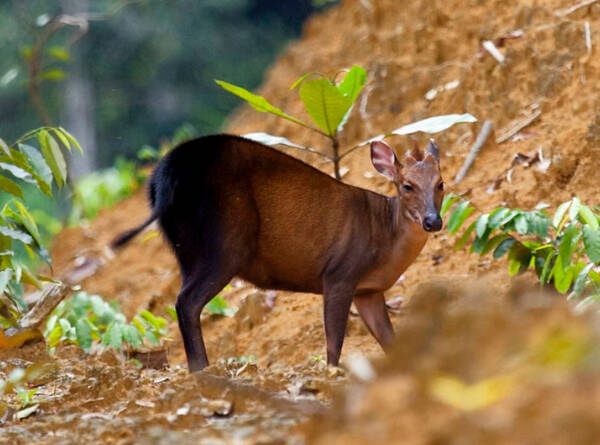Cephalophus callipygus
IUCN
LCBasic Information
Scientific classification
- name:Cephalophus callipygus
- Scientific Name:Cephalophus callipygus
- Outline:Ungulata
- Family:Artiodactylus Bovidae Gazella
Vital signs
- length:80-115cm
- Weight:15-24kg
- lifetime:About 10 years
Feature
The horns are surrounded by a rich tuft of tawny hair
Distribution and Habitat
Distributed in west-central Africa, west of the Congo River, southern and southeastern Cameroon, southwestern Central African Republic, mainland Equatorial Guinea, Gabon, northern and southwestern Congo.
The duiker occurs at altitudes from sea level to 1200 m. Lowland rainforests of west-central Africa, with dense undergrowth being an important habitat feature, providing shelter. Lives in relatively undisturbed or primary forest areas, but also occurs in logged forests with dense undergrowth, and is sometimes recorded in secondary forests and farm shrubs.
Appearance
The head and body length of the blue-rumped duiker is 80-115 cm, the shoulder height is 45-60 cm, the tail length is 10-16 cm, and the weight is 15-24 kg. It is a small reddish-brown antelope, and the color varies greatly between individuals. The fur on the lower body is lighter than the back. A black dorsal line runs along the spine starting between the shoulders and extending to the back. Some individuals also have dark legs, shoulders, necks and faces. There are two pale spots under and behind the eyes. Both sexes have thorn-like horns that extend backwards from the forehead. The male's horns average 8-10 cm long, while the female's horns are generally 4.0-5.8 cm long. There is a tuft of rich yellow-brown hair around the horns.
Details
Blue-rumped duiker (scientific name: Cephalophus callipygus) English: Peters' Duiker, Gabon Duiker, French: Céphaplophe de Peter, German: Petersducker, Schönsteißducker, no subspecies.

In the wild, the "red duikers" are often difficult to tell apart, especially when they're running. Even photos can be a challenge, depending on the angle. A stripe down the back that extends to the rump is characteristic of the blue-rumped duiker. The bay duiker most closely resembles the blue-rumped duiker, but they are nocturnal and also have a narrow stripe down the back to the tail. Similarly, the Austronesian duiker can be identified by its narrow dorsal stripe. The white-bellied duiker has a stripe on its back that widens down the center of the back. The belly is distinctly pale. The black-fronted duiker and the Wessler duiker lack a dorsal stripe.
The blue-rumped duiker is usually solitary, but a male and several females often live in the same area, with a hierarchy. It is active during the day and rests or sleeps at night. These diurnal habits allow the blue-rumped duiker to coexist with other nocturnal duikers, but are otherwise very similar, and they can share territories with the bay duiker. The blue-rumped duiker usually forages in open areas, but will flee to areas with dense vegetation if threatened. Daytime resting areas are usually in the bush, but sleeping sites at night are usually in areas with the least bush. An adult female occupies a home territory of about 40 hectares; this overlaps with the territories of several other females and one male. Males are considered to be very territorial and will not allow other males to enter their territory. The population density is 0.6-15.5 animals per square kilometer. The main food is fruit, and they also eat plant leaves, flowers, fungi and some animal matter.
The blue-rumped duiker can reproduce throughout the year, but more young are born in the early dry season (May-June and December) when fruits are most abundant. The gestation period is 240 days. One calf is born per litter. The weaning period is unknown, but it may be around 4 months. The newborn calves have dark brown fur and the black dorsal stripes of the adults. Sexual maturity is around 18 months.
The blue-rumped duiker is widely distributed and relatively abundant, with an estimated total of more than 350,000 as of 2016. However, with the opening of forest areas in Central Africa and human colonization, increased hunting pressure suggests that the species may eventually be eliminated from most of its distribution. The main threats to the survival of the species are hunting (especially through the use of snares) and habitat loss caused by human settlement and agricultural expansion. In some areas with high hunting pressure and human disturbance, these factors have led to localized reductions to very low levels.
Listed in the IUCN Red List of Threatened Species in 2016 ver3.1 - Least Concern (LC).
Protect wildlife and eliminate bushmeat.
Maintaining ecological balance is everyone's responsibility!








